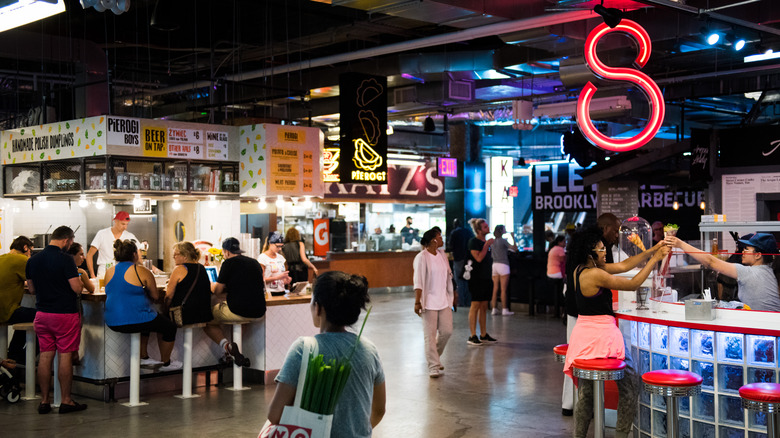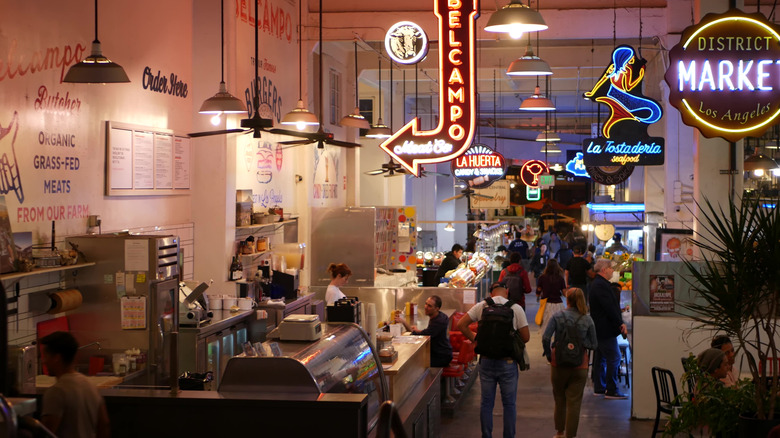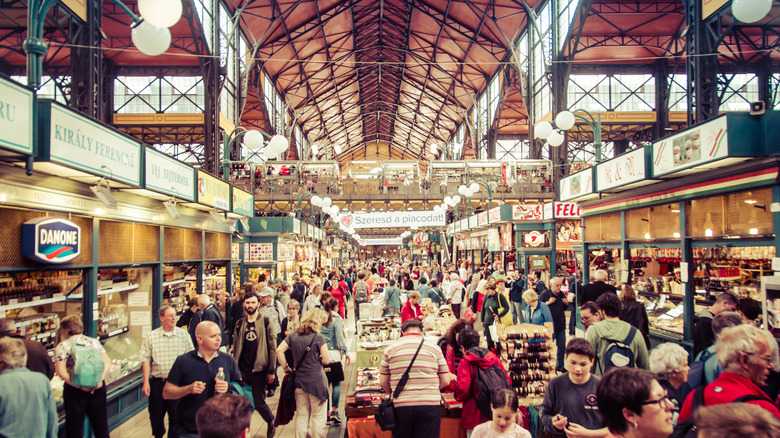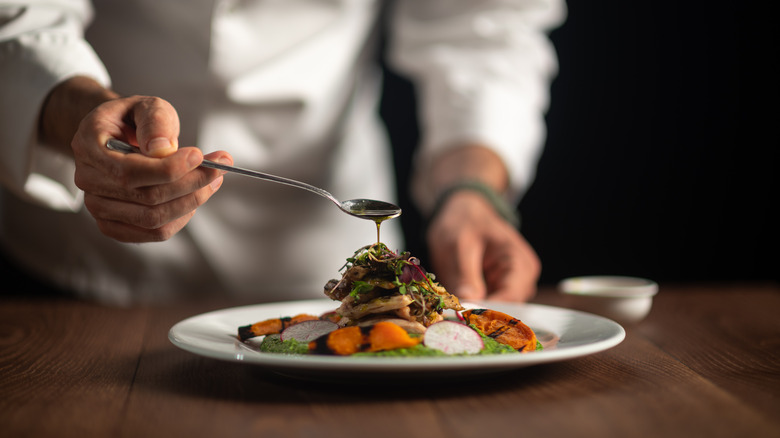How Michelin-Level Cuisine Entered The Food Hall Landscape
If you're lucky, you live near a great food hall, such as DeKalb Market Hall in Brooklyn or Grand Central Market in downtown Los Angeles. And if you're really lucky, then you live next to a food hall that features Michelin-level cuisine. While fine dining and food halls may not seem like they go together, over the past few years, highly praised chefs have been moving into the food hall scene.
To find some notable examples of this phenomenon, look no further than State Street Market, a food hall in Los Altos, California, which has a history of hosting Michelin-starred chefs. Firstly, there's the Indian restaurant, Little Blue Door, which is co-owned by Srijith Gopinathan whose other restaurant is the two-Michelin-starred Indian restaurant Ettan (also in Palo Alto).
Also, State Street Market used to be the home of Bǎo Bèi, which is now closed. However, it represented yet another example of Michelin-starred chefs taking advantage of the hustle and bustle of a food hall to showcase their food. Bǎo Bèi (which offered affordable bao buns and dan dan noodles) was headed by married chefs Michael and Meichih Kim. The Kims are known for Maum, a Michelin-starred Palo Alto Korean restaurant that cost $165 per guest for the tasting menu while it was still open.
And the Kims and Gopinathan are far from the only chefs making a beeline for a food hall spot. So what is the reasoning behind the uprise of fine dining in food halls?
Food halls in general have become more popular
One major perk of a food hall is all of the options that it allows for each person. On this topic, Lauren Johnson, marketplace manager for High Street Place in Boston, told Ellison Insider, "Guests can really get a taste of all that Boston has to offer under one roof." With this in mind, it makes sense that the food hall business has been growing exponentially. Currently, there are about 200 food halls in the United States — with almost just as many in development.
The food hall has become distinct from the food court typical to a mall, with food halls containing higher quality food and even boasting their own activities. For example, Elliman Insider reported that the Tin Building in Lower Manhattan has activities such as tarot card reading and getting a custom piece by a portrait artist. The Tin Building, along with other food halls, host regular events. Further, Johnson of High Street Market thinks that the rise in popularity of food halls has a whole lot to do with the fact that people are more eager than ever for social activities post-pandemic.
With such an influx of people being driven to food halls for the social atmosphere as well as the food, it makes sense that chefs — even high-end, Michelin-starred chefs — would want to secure a place there in order to get their food out to the most people. Plus, chefs have been dealing with their own repercussions of the pandemic.
The pandemic impacted the food industry
The pandemic led to a massive amount of restaurants being forced to close. The National Restaurant Association estimated that about 90,000 restaurants closed due to COVID, either permanently or temporarily, as of spring 2021. In such a harsh landscape, food halls have offered somewhat of a solace to chefs and restaurant owners.
Speaking to Fine Dining Lovers, Chicago chef Bryan Enyart — whose resume includes leading the Michelin-starred Mexican restaurant Topolobampo — spoke about the appeal of the food hall and why he decided to open Dos Taqueria inside Revival Hall Food Market in 2021. Enyart said, "The overhead for a restaurant is insane, and to open a place in a food hall is much easier, the financial commitment is much lower." Namely, food halls operate on an annual contract, so each chef or owner only commits to 12 months — which is much less intimidating in the aftermath of the pandemic.
One food hall in Washington, D.C., The Square, which opened in Spring of 2023, is intentionally creating a space that has all its vendors in mind — and many chefs may be comforted by this considering how harsh culinary life has been since COVID. One of the collaborators behind The Square, Richie Brandenburg, told the Washingtonian that he conceived the space to be a collaborative one, where all resources — everything from kitchen resources to accounting — are shared between all food stall chefs and employees. Brandenburg said, "We want to create a model here that works for everyone."
Fine dining chefs use their skills at food halls
Besides the financial benefits, fine dining chefs have found that they are able to utilize their skills just as well in food halls. Srijith Gopinathan, the Michelin-starred chef who co-owns Little Blue Door at State Street Market in Palo Alto spoke to Fine Dining Lovers about what this topic. Gopinathan said, "My fine-dining background does help in careful pre-preparation of food, to make sure the finished food is cleaner and finer." For example, she knows how to utilize her time extremely well in a fast-paced environment — and the food hall certainly falls into this category as each stall has to keep it moving in order to get through the influx of hungry customers.
Robert Guimond — former chef of the Michelin-acknowledged New York pizzeria Roberta's and the newly opened PDA Slice Shop in a food hall called The Hugh — agrees with Gopinathan. Further, Guimond sees food halls as an opportunity to use the finest ingredients in a more casual space. Guimond said, "I can approach well-sourced flour with the same reverence and excitement in which I approach a well sourced beef tenderloin."
Similarly, Patricia Wall, the co-owner of The Market at Malcolm Yards in Minneapolis, thinks that chefs are drawn to food halls because of the freedom it allows them. Wall told Flavor & The Menu, "Food halls give chefs an opportunity to launch themselves into something different. They can experiment and do it with a lot less risk."



